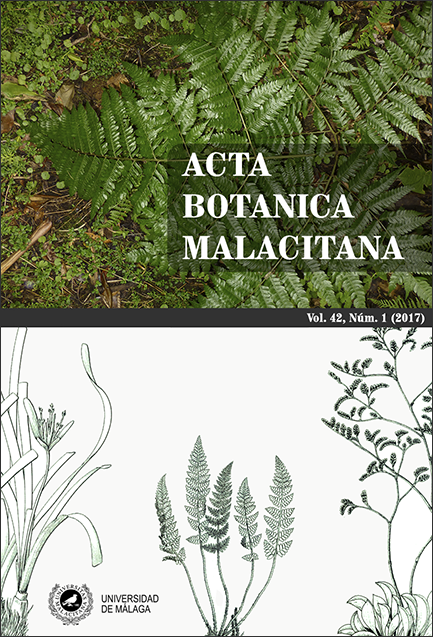Funtional Ecology of fronds in Iberian saxicolous ferns
DOI :
https://doi.org/10.24310/abm.v42i1.3093Résumé
Nowadays, functional traits are widely used to study autoecological aspects in plant species. The analysis of these traits among climatic gradients allows us to know the strategy that plants follow depending on resource availability. Referring to plants, the traits measured in the leaves have a special importance; among these traits we can find SLA (Specific Leaf Area), LDMC (Leaf Dry- Matter Content) and LT (Leaf Thickness). In this work, these traits are measured in four species of the genus Asplenium. As extremes of a climatic gradient, we have focused our study in both bioclimatic regions existing in the Iberian Peninsula. Taking into account the differences referring to the resource availability for the species in each region, the main goal of this work is analyzing the variations of the three functional traits mentioned in the four species in both locations and associate these variations to macroclimatic variables. To this aim, fronds from the four species were collected in populations of each bioclimatic region to determine the fresh weight, dry weight and the foliar area. From these variables, we calculated the three functional traits. The results have shown that ferns adopt higher productive yields in the Mediterranean region (higher SLA values) and lower LDMC and LT values than in the Eurosiberian region. As to the climate variables effects, the average of the maximum temperatures in the warmest month (TMAX) is the variable that better explains the differences in the productive yield that the plants adopt in each region. On the other hand, annual precipitation seems not to play an important role on any of the functional traits in any of the species. Finally, we didn’t find a generalized tendency in the effects of the extern variables: frozen period, minimum temperatures in the coolest month and arid period.
Téléchargements
Métriques
Références
Aspelmeier, S. & Leuschner, C. (2006). Genotypic variation in drought response of silver birch (Betula pendula Roth): leaf and root morphology and carbon partitioning. Trees 20: 42-52.
Casper, B.B., Forseth, I.N., Kempenich, H., Seltzer, S. & Xavier, K. (2001). Drought prolongs leaf life span in the herbaceous desert perennial Cryptantha flava. Functional Ecology 15: 740-47.
Chapin, F.S., Carpenter, S.R., Kofinas, G.P., Folke, C., Abel, N., Clark, W.C., Olsson, P., Stafford, D.M., Smith, B.H., Young, O.R., Berkes, F., Biggs, R., Grove, J.M., Naylor, R.L., Pinkerton, E., Steffen, W. & Swanson, F.J. (2010). Ecosystem stewardship: sustainability strategies for a rapidly changing planet. Trend in Ecology and Evolution 25: 241-249.
Chen, F.M., Niklas, K.J. & Zeng, D.H. (2011). Important foliar traits depend on species-grouping: analysis of a remnant temperate forest at the Keerqin Sandy Lands, China. Plant and Soil 340: 337-345.
Ferrer, D. & Vetaas, O.R. (2005). Pteridophyte richness, climate and topography in the Iberian Peninsula: comparing spatial and nonspatial models of richness patterns. Global Ecology and Biogeography 14: 155- 165.
Galmés, J., Medrano, H. & Flexas, J. (2007). Photosynthetic limitations in response to water stress and recovery in Mediterranean plants with different growth forms. New Phytologist 175: 81-93.
Galmés, J., Ochogavía, J.M., Gavo, J., Roldán, E. J., Cifre, J. & Conesa, M.A. (2013). Leaf responses to drought stress in Mediterranean accessions of Solanum lycopersicum: anatomical adaptations in relation to gas exchange parameters. Plant, Cell & Environment 36: 920-935.
Garnier, E., Cortez, J., Billès, G., Navas, M.L., Roumet, C., Debussche, M., Laurent, G., Blanchard, A., Aubry, D., Bellmann, A., Neill, C. & Toussaint, J.P. (2004). Plant functional markers capture ecosystem properties during secondary succession. Ecology 85: 2630–2637.
Given, D.R. (1993). Changing Aspects of Endemism and Endangerment in Pteridophyta. Journal of Biogeography 20: 293-302.
Grime, J.P., Thompson, K., Hodgson, J.G., Cornelissen, J.G., Rorison, I.H., Hendry, G.A.F., Ashenden, T.W. & Askew, A.P. (1997). Integrate Screening Validates Primary Axes of Specialisation in Plants. Nordic Soeciety Oikos 79: 259-281.
Joffre, R., Ramal, S. & Damesin, C. (1999). Functional attributes in Mediterranean-type ecosystems. In F. I. Pugnaire & F. Valladares (eds.), Handbook of Functional Plant Ecology: 347–380. New York.
Lakso, A.N. (1985). The effects of water stress on physiological processes in fuit crop. Acta Horticulturae 171: 275-289.
Larson, D.W., Matthes, U. & Kelly, P.E. (2005). Cliff Ecology. Birks, H.J.B. & Wiens, J.A (Eds.) Cambridge University Press, New York.
Mccree, K.J (1986). Whole plant carbon balance during osmotic adjustment to drought and salinity stress. Australian Journal of Plant Physiology 13: 33-44.
Mehltreter, K., Walker, L.R. & Sharpe, J.M. (2010). Fern ecology. Cambridge University Press, Cambridge.
Moreno, J.C. & Lobo, L.M. (2008). Iberian–Balearic fern regions and their explanatory variables. Plant Ecology 198: 149-167.
Nuzzo, V. (1996). Structure of cliff vegetation on exposed cliffs and the effect of rock climbing. Canadian Journal of Botany 74: 607-617.
Page, C.N. (2002). Ecological strategies in fern evolution: a neopteridological overview. Review of Palaeobotany and Palynology 119: 1-33.
Pérez-Harguindeguy, N., Díaz, S., Garnier, E., Lavorel, S., Poorter, H., Jaureguiberry, P., Bret-Harte, M.S., Cornwelf, K., Craine, J.M., Gurvich, D.E., Urcelay, C., Veneklaas, E.J., Reich, P.B., Poorter, L., Wright, I.J., Ray, P., Enrico, L., Pausas, J.G., De Vos, A.C., Buchmann, N., Funes, G., Quiétier, F., Hodgson, J.G., Thompson, K., Morgan, H. D, Ter Steege, H., Van De Heijden, M.G.A, Sack, L., Blonder, B., Poschold, P., Vaieretti, M.V., Conti, G., Staver, A.C., Aquino, A., Cornelissen, J.H.C. (2013). New handbook for standardised measurement of plant functional traits worldwide. Australian Journal of Botany 61: 167-234.
Poorter, L. & Bongers, F. (2006). Leaf traits are good predictors of plant performance across 53 rain forest species. Ecology 87: 1733–1743.
Poorter, H. & De Jong, R. (1999). A comparison of specific leaf area, chemical composition and leaf construction cost of field plants from 15 habitats differing in productivity. New Phytologist 143: 163-76.
R CORE TEAM (2013-R): A language and environment for statistical computing. R Foundation for Statistical Computing, Vienna, Austria.
Rasband, W.S. (2007). ImageJ, US National Institutes of Health, Bethesda, Maryland, USA.
Reich, P.B., Walters, M.B. & Ellsworth, D.S. (1997). From tropics to tundra: Global convergence in plant funtioning. Proceedings of the National Academy of Sciences of the United States of America 94: 13730– 13734.
Rivas-Martinez, S. (1987) Memoria del mapa de Series de Vegetación de España. I.C.O.N.A. Serie Técnica. Publ. Ministerio Agricultura, Pesca y Alimentación. Madrid.
Salvo, E. (1990). Guía de helechos de la Península Ibérica y Baleares. Ediciones pirámide. Madrid.
Terradas, J. (2001). Ecología de la vegetación: de la ecofisiología de las plantas a la dinámica de comunidades y paisajes. Terradas, J. (Ed). Ediciones Omega, Barcelona.
Tyron, R.M. (1964). Evolution in the leaf of living ferns. Memoirs of Torrey Botanical Club 21: 73-82.
Vasheka, O., Puglelli, G., Crescente, M.F., Varone, L. & Gratani, L. (2017) Anatomical and morphological leaf traits of three evergreen ferns (Polystichum setiferum, Polypodium interjectum and Asplenium scolopendrium). American Fern Journal 4: 258-268.
Vile, D., Garnier, R., Shipley, B., Laurent, G., Navas, M.L., Roument, C., Lavorel, S., Díaz, S., Hodgson, J.G, Lloret, F., Midgley, G.F., Poorter, H., Rutherford, M.C., Wilson, P.J., Wright, I.J. (2005). Specific leaf area and dry matter content estimate thickness in laminar leaves. Annals of Botany 96: 1129-1136.
Violle, C., Navas, M.L., Vile, D., Kazakou, E., Fortunel, C., Hummel, I. & Garnier, E. (2007). Le concept of trait be funtional! Oikos 116: 882-892.
Wilson, P. J., Thompson, K.E.N. & Hodgson, J.G. (1999). Specific leaf area and leaf dry matter content as alternative predictors of plant strategies. New Phytologist 143:155-162.
Went, F. W. (1950). The response of plants to climate. Science 112: 489-494.
Téléchargements
Publiée
Comment citer
Numéro
Rubrique
Licence
Toutes les informations concernant la licence d'utilisation des travaux publiés dans Acta Botanica Malacitana et les droits d'auteur sont disponibles dans notre Politique Éditoriale.







1.png)


